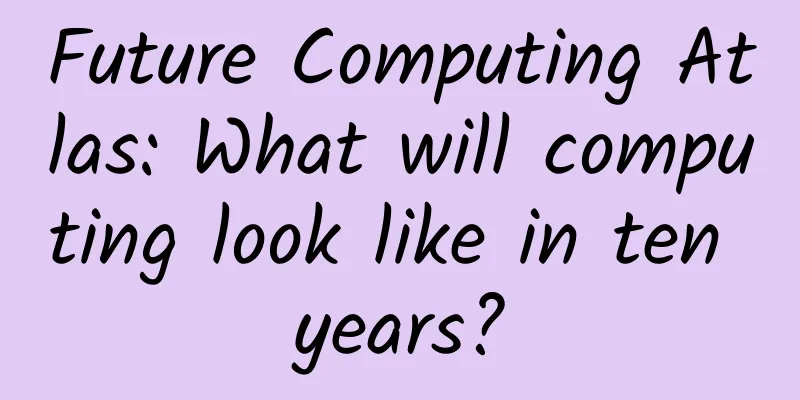Future Computing Atlas: What will computing look like in ten years?

|
Amid the turmoil of the global economic downturn caused by the epidemic, predicting the future amid uncertainty is a reference for industry participants to adjust their course, and it is also an exploration for the industry to seek consensus on future development. In the intelligent era, connectivity, storage, and computing power are recognized as the cornerstones of development. What kind of future will these cornerstones build? To discuss what the intelligent era will look like in the next 10 years, we need to predict the possible development trends of future computing. After all, the bricks and tiles of computing will build the building of future intelligence. So, what will be the trend of computing development in the next decade? To answer this question, we need to find the trendsetters in the cutting-edge technology field in the digital intelligence era, understand their strategies and choices, thinking and practice, and observe these industry pacesetters who are closest to the trend or even create the trend, so as to capture the future direction. Future computing: a necessity for industry upgrade Ten years ago, mankind entered the ZB data era, and emerging technologies such as mobile Internet, cloud computing, and big data were just starting to take off. Ten years later, these technologies have been deeply integrated into thousands of industries, and computing has played an unprecedented role. Ten years from now, we will enter the YB era. It is estimated that by then, the global data will increase by 1 YB per year, general computing power will increase 10 times to 3.3 ZFLOPS, and artificial intelligence computing power will increase 500 times to more than 100 ZFLOPS. In the next ten years, computing will lead us into a brand new intelligent world. To build the future intelligent world, what changes in computing are needed? To explore the answer to the development trend of computing in the next ten years, we first need to clarify why computing needs to develop on a large scale in the future and what is the driving force behind its development. In the current technological development, computing is facing the need for upgrading in actual implementation and trend promotion. The digital world and the physical world are seamlessly integrated, and the boundaries of scientific exploration are expanded, which has led to an increase in demand for computing power. The development of various industries under the wave of digitalization relies on the empowerment of computing. At the same time, driven by the long-term dual-carbon strategic goals, traditional industries are also in urgent need of green computing reforms, which also makes computing more closely connected with industrial upgrading, social economy, and the environment. Artificial intelligence is moving from perception to cognition. For thousands of industries, high-demand computing tasks and computing architectures also need to be continuously upgraded to solve complex and diverse scenario problems in various industrial fields such as production, transportation, medical care, and manufacturing. For the development of computing, Moore's Law and Shannon's limit are the limitations of its development process. This also means that computing has entered a new stage of self-revolution and innovation. The next ten years will be a critical decade for the development of computing. Computing needs to break through the boundaries of old algorithms, software, architecture, materials, etc. This will also bring new "fuel" to the development of industry and economy, and open a new era of more intelligent, green and secure computing for postmodern humans. Driven by the wave of digital intelligence development, the development of thousands of industries relies on computing empowerment, from the bottleneck of computing development to innovation, to the needs of full industry upgrading and the development of green economy, new demands have been put forward for computing and computing infrastructure. Computing needs to develop in all aspects to cope with the big test of the future intelligent world. So in which specific directions should computing develop in the next decade? Huawei, an industry leader, brought us some thoughts from a practitioner's perspective at the analyst conference. Ten years of computing: The evolution of six technology characteristics Moore's Law and Shannon's limit define the technological limits of this era. If we want to reach the next computing era, we must start with systematic breakthroughs in innovation limits. What new forms of computing will take in the next decade? We can get a glimpse of the future of computing from these six technical forms. 1. Physical layer breakthrough. As current semiconductor processes gradually approach physical limits, physical layer breakthroughs will be used in the future to improve computing energy efficiency and storage density and realize industrial technology revolution. The main directions include analog computing, non-silicon-based computing, and new storage. For example, in terms of improving energy efficiency and density, quantum computing and optical computing will be representative technologies for analog computing in the future. It is expected that 1,000 quantum bit chips will appear in 2025 and be commercialized in specific scenarios. Storage will revolve around the differences in hot, warm, and cold data throughout its life cycle. In the future, media will also evolve in the two directions of high speed and high performance and massive low cost to meet the core demands of real-time, high efficiency, and low cost for accessing large amounts of data for data storage. 2. Diversified computing. Future converged applications will require diverse computing, which will shift from being CPU-centric to being data-centric and evolve toward a symmetric computing architecture. In a symmetric computing architecture, the bus is the core. In the future, a DC-level computing bus will appear. With the support of the new bus, new computing architectures such as symmetric computing, ubiquitous computing, and storage-computing integration will be gradually realized, and the software stack will also be fully reconstructed. 3. Multi-dimensional collaboration. This includes two aspects: three-dimensional computing and digital twins. In the future, cloud, edge, and end will collaborate and cooperate horizontally and vertically to complement each other's strengths and form three-dimensional computing. It is expected that the penetration rate of edge intelligence in the industry will reach 40% in 2025, and the edge-cloud architecture will become a standard in the industry and achieve large-scale commercial use. Driven by applications such as smart cities and smart factories, digital twins will also be accelerated. 4. Intelligent cognition. AI technology will move from perception to cognition, and from cognition to creation. From perceptual intelligence to cognitive intelligence, it is expected that in 2025, it will be applied in search/recommendation/dialogue and other reasoning scenarios, and in 2030, machines will replace humans in local scenarios; from cognitive intelligence to creative intelligence, generative AI will be achieved. It is expected that by 2030, AI will be able to actively search for training data, achieve self-update, self-evolution, and self-creation. 5. Intrinsic security. In the future, computing security will become an intrinsic capability of the system and will run through the entire life cycle of data. It is expected that a globally recognized consensus algorithm will appear in the field of digital identity in 2026, and homomorphic encryption performance will be improved by 1,000 times, and commercial use will be initially realized. With the popularization of AI applications, AI security and reliability will become increasingly important. It is expected that by 2026, the robustness of AI models will increase from the current 5% to more than 80%. With the emergence of new computing paradigms, it is also necessary to build new security architectures and systems. Security will be integrated into new computing architectures such as network computing, diverse computing, and peer-to-peer computing. 6. Green and intensive. Intensive construction, improving computing power utilization, and reducing unit computing power energy consumption are the main ways to achieve green and intensive computing. Specific implementation methods include chip engineering, integrated DC and computing power network. The computing power network connects data centers in various places through new network technologies to realize computing power service, realize intensive construction and reuse of computing power at the social level, and improve computing power utilization. It is expected that by 2030, there will be a computing power network with more than 100 city nodes. Facing the complex application scenarios of the future, single-point technology or innovation is unlikely to support the future demand for 100-fold or 1,000-fold computing power. Therefore, the six major technical features of Computing 2030 are not isolated from each other. It is necessary to achieve system-level innovation and full-factor collaboration to allow the multiplier effect of various technology dividends and innovation dividends, so as to truly meet the computing power needs of future computing scenarios and drive the continuous iterative evolution of the computing industry. Facing the future: Practitioners’ computing development From a global perspective, computing power has become a key productivity supporting the development of the digital economy. The world is increasing investment in computing power infrastructure construction, and high-performance computing investment and construction has become a significant trend. China's data infrastructure is also being actively built in this era. The "East Data West Computing" project, which was launched at the beginning of the year, has integrated the country's big data center and coordinated the layout of eight major city hubs and ten clusters. Sixty years ago, when Kilby developed the world's first integrated circuit, no one could have imagined that computers and the Internet would shape the world into what it is today. Similarly, the intelligent computing revolution we are experiencing today will also lead the world to a broader future. |
<<: I have wormwood, where can malaria go?
>>: In the post-apocalyptic night, light up the earth with fireflies, mushrooms and bacteria!
Recommend
Zhangye wedding WeChat applet function, how much does it cost to develop a wedding WeChat applet?
As those born after 1995 and 2000 reach marriageab...
One code for all travel across the country, do you need to be quarantined when returning home? The latest situation of 31 provinces, autonomous regions and municipalities is here!
The Spring Festival is coming soon. Are you plann...
How do optimizers quickly measure the running volume of materials?
In this article, we will talk about the basic ide...
TV version of Resident Evil "Broken Dawn 2" TV version first test
"Best seller" and "heavy" are...
Zhong Nanshan: Omicron infection is not scary, 99% can fully recover within 7 to 10 days!
At the "Chinese Medical Association Respirat...
How do big self-media accounts make money?
The fans of emotional self-media are ordinary peo...
How can brands leverage marketing opportunities on Labor Day?
For a company, there are never enough festivals, ...
How important is the attribution model in multi-channel promotion? The secret to quickly reducing conversion costs!
Today I would like to talk to you about the value...
The most "perverted" food hoarding: They turned cockroaches into living food reserves
We have all heard this fable: in the summer, ants...
With fossils being unearthed one after another, China's "paleoanthropology" is becoming more and more "new"!
In July 2024, the China Association for Science a...
You lie down, but your brain is still learning at 20 times the speed
Life experience tells us that it is important to ...
SAIC Motor delivered 750 “government reception vehicles” to the CIIE
(October 12, 2024, Shanghai) Today, the "Del...
Witnesses, not just stones
Witnesses Are Not Just Stones Author: Mao Ning Sc...
How far away from the Milky Way disk can we see the entire Milky Way?
A friend asked: If the solar system moves slightl...
NetEase Cloud Music AARRR model growth analysis!
A while ago, NetEase Cloud Music ’s annual report...









